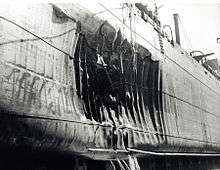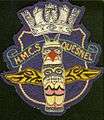HMCS Quesnel
 HMCS Quesnel, 10 September 1942, off Vancouver Island | |
| History | |
|---|---|
| Name: | Quesnel |
| Namesake: | Quesnel, British Columbia |
| Ordered: | 14 February 1940 |
| Builder: | Victoria Machinery Depot Co. Ltd. Victoria |
| Laid down: | 9 May 1940 |
| Launched: | 12 November 1940 |
| Commissioned: | 23 May 1941 |
| Decommissioned: | 3 July 1945 |
| Identification: | Pennant number: K133 |
| Honours and awards: | Atlantic 1942-45;[1] Gulf of St. Lawrence 1944[2] |
| Fate: | scrapped 1946. |
| General characteristics | |
| Class and type: | Flower-class corvette (original)[3] |
| Displacement: | 925 long tons (940 t; 1,036 short tons) |
| Length: | 205 ft (62.48 m)o/a |
| Beam: | 33 ft (10.06 m) |
| Draught: | 11.5 ft (3.51 m) |
| Propulsion: |
|
| Speed: | 16 knots (29.6 km/h)(18.4mph) |
| Range: | 3,500 nautical miles (6,482 km) at 12 knots (22.2 km/h)(13.8mph) |
| Complement: | 85 |
| Sensors and processing systems: |
|
| Armament: |
|
HMCS Quesnel was a Flower-class corvette of the Royal Canadian Navy that took part in convoy escort duties during the Second World War. She primarily saw service in the Battle of the Atlantic. She was named after Quesnel, British Columbia.
Background
Flower-class corvettes like Quesnel serving with the Royal Canadian Navy during the Second World War were different from earlier and more traditional sail-driven corvettes.[4][5][6] The "corvette" designation was created by the French for classes of small warships; the Royal Navy borrowed the term for a period but discontinued its use in 1877.[7] During the hurried preparations for war in the late 1930s, Winston Churchill reactivated the corvette class, needing a name for smaller ships used in an escort capacity, in this case based on a whaling ship design.[8] The generic name "flower" was used to designate the class of these ships, which – in the Royal Navy – were named after flowering plants.[9]
Corvettes commissioned by the Royal Canadian Navy during the Second World War were named after communities for the most part, to better represent the people who took part in building them. This idea was put forth by Admiral Percy W. Nelles. Sponsors were commonly associated with the community for which the ship was named. Royal Navy corvettes were designed as open sea escorts, while Canadian corvettes were developed for coastal auxiliary roles which was exemplified by their minesweeping gear. Eventually the Canadian corvettes would be modified to allow them to perform better on the open seas.[10]
Construction
Quesnel was originally ordered by the Royal Navy 4 February 1940 as part of the 1939-1940 Flower-class building program. She was laid down by the Victoria Machinery Depot Company Ltd. in Victoria, British Columbia on 9 May 1940 and launched 12 November 1940.[11] She was commissioned on 23 May 1941, at Esquimalt.[12][13]
On 15 May 1941 Quesnel was one of ten corvettes loaned to Canada. She could be told apart from other Canadian Flower-class corvettes by her lack of minesweeping gear and the siting of the after gun tub amidships. However, Quesnel was completed after the exchange, so she was commissioned with a Canadian name and not a flower name like the other nine that had been transferred.[10]
Wartime service
Upon commissioning, Quesnel patrolled the Pacific Coast as a member of Esquimalt Force. During the spring of 1942 she was doing anti-submarine patrols in the Straits of Georgia, the Queen Charlotte Sounds and Millbank Sounds. It was during this time that she was detailed to screen RMS Queen Elizabeth[14] while she was waiting to go into drydock.

On 20 June 1942, the Imperial Japanese Navy submarine I-26 shelled the lighthouse at Estevan Point on Vancouver Island, while I-25, under the command of Commander Meiji Tagami, torpedoed and shelled the freighter SS Fort Camosun off Cape Flattery.[15] The freighter did not sink and she was towed to safety by Quesnel into Victoria Harbour.[12]
Quesnel left Esquimalt on 13 September 1942, with four other corvettes headed for Panama and the Atlantic. Transferred to the east coast to replace a ship taking part in Operation Torch, Quesnel arrived at Halifax on 13 October 1942, and was assigned to the Western Local Escort Force (WLEF). With the division of the force into escort groups in June 1943, she became a member of EG W-1. During this period she underwent a refit, including fo’c’s’le extension, from early September to 23 December 1943, at Pictou, Nova Scotia. This refit was followed by workups in St. Margaret’s Bay, Nova Scotia and Bermuda.
On 12 May 1944, she picked up 17 crew members from the damaged SS Esso Pittsburgh. Quesnel later joined the Quebec Force in the St. Lawrence River on 10 June 1944, and was tasked with escorting Labrador-Quebec convoys through the ice fields in the Straits of Belle Isle.
In November 1944 she was transferred to Halifax Force, going to Sydney, Nova Scotia for refit and, on completion late in January 1945, to Bermuda for workups. She resumed escort duty late in March 1945, temporarily attached to EG W-5 and W-8 of the WLEF until the end of the war.
She brought her last convoy to Halifax in July 1945 and was decommissioned on 3 July 1945. She was the only one of the ten corvettes transferred from the Royal Navy who was not returned. She was sold on 5 October 1945, to the United Steel and Metal Company in Hamilton, Ontario for scrapping. She was finally broken up at Hamilton in 1946.[12]
The Thunderbird
During the summer of 1942, while coming through Hecate Strait in the Queen Charlottes, Quesnel sheltered from a storm in Alert Bay, British Columbia. While ashore, some crew members removed a carved Thunderbird from a local burial ground. The grave marker was for a man named Michael Dutch, from the Kwakwaka'wakw First Nation who died circa 1922. The crew members considered the totem a lucky talisman and had it depicted on the ship's badge.[16] There are persistent rumours that the Thunderbird totem still exists and in 2007 some of the Quesnel's former sailors issued a public plea for its return.[17]
 HMCS Quesnel crew with Thunderbird
HMCS Quesnel crew with Thunderbird Badge of HMCS Quesnel
Badge of HMCS Quesnel
Commanding officers
T/Lt. John Alexander Gow, RCNR 22 April 1941 – 4 March 1942
T/Lt. Albert Elliot Gough, RCNR 5 March 1942 – 3 April 1942
T/Lt. John Alexander Gow, RCNR 4 April 1942 – 16 November 1942
T/Lt. Murdo Smith, RCNR 17 November 1942 – 11 April 1943
T/Lt. John MacKay Laing, RCNR 12 April 1943 – 3 July 1945
Notes
- ↑ "Battle Honours". Britain's Navy. Retrieved 23 August 2013.
- ↑ "Royal Canadian Warships - The Battle of the Gulf of St. Lawrence - Second World War". Veterans Affairs Canada. Retrieved 23 August 2013.
- ↑ Lenton, H.T.; Colledge, J.J (1968). British and Dominion Warships of World War II. Doubleday & Company. pp. 201, 212.
- ↑ Ossian, Robert. "Complete List of Sailing Vessels". The Pirate King. Retrieved 13 April 2011.
- ↑ Fitzsimons, Bernard, ed. (1978). The Illustrated Encyclopedia of 20th Century Weapons & Warfare. 11. London: Phoebus. pp. 1137–1142.
- ↑ Jane's Fighting Ships of World War II. New Jersey: Random House. 1996. p. 68. ISBN 0-517-67963-9.
- ↑ Blake, Nicholas; Lawrence, Richard (2005). The Illustrated Companion to Nelson's Navy. Stackpole Books. pp. 39–63. ISBN 0-8117-3275-4.
- ↑ Chesneau, Roger; Gardiner, Robert (June 1980). Conway's All the World's Fighting Ships (1922–1946). Naval Institute Press. p. 62. ISBN 0-87021-913-8.
- ↑ Milner, Marc (1985). North Atlantic Run. Naval Institute Press. pp. 117–119, 142–145, 158, 175–176, 226, 235, 285–291. ISBN 0-87021-450-0.
- 1 2 Macpherson, Ken; Milner, Marc (1993). Corvettes of the Royal Canadian Navy 1939–1945. St. Catharines: Vanwell Publishing. ISBN 1-55125-052-7.
- ↑ "HMCS Quesnel (K 133)". Uboat.net. Retrieved 23 August 2013.
- 1 2 3 Macpherson, Ken; Burgess, John (1981). The ships of Canada's naval forces 1910–1981 : a complete pictorial history of Canadian warships. Toronto: Collins. pp. 83, 231–232. ISBN 0-00216-856-1.
- ↑ http://www.navy.gc.ca/project_pride/ships/ship_e.asp?shipNumber=129
- ↑ Archived 29 May 2009 at the Wayback Machine.
- ↑ Webber, Bert (1975). Retaliation: Japanese Attacks and Allied Countermeasures on the Pacific Coast in World War II. Oregon State University Press. ISBN 0-87071-076-1.
- ↑ "Culture ::". Travel Thru History. Retrieved 2013-01-10.
- ↑ Lambie, Chris (23 March 2007). "Ex-sailors hunting for stolen totem; Crew members want to return carving taken from B.C. graveyard in 1940s". The Chronicle-Herald. Nova Scotia. pp. B3.
References
- Johnston, Mac (1994). "Corvettes Canada : convoy veterans of WWII tell their true stories" Toronto: McGraw-Hill Ryerson. ISBN 0-07-551381-1.
- Lamb, James B (1977). "The Corvette Navy". Toronto: Macmillan of Canada. ISBN 0-7737-6127-6.
- Lundahl, Bev (2007). "The Flight of the Thunderbird", Beaver Magazine, December 2007/January 2008. Volume 87, No. 6, p 56-57.
- Macpherson, Ken; Milner, Marc (1993). "Corvettes of the Royal Canadian Navy 1939-1945". St. Catharines: Vanwell Publishing. ISBN 0-920277-83-7.
External links
| Wikimedia Commons has media related to HMCS Quesnel (K 133). |
- Canadian Navy Heritage Project: Ship Technical Information
- Canadian Navy Heritage Project: Photo Archive